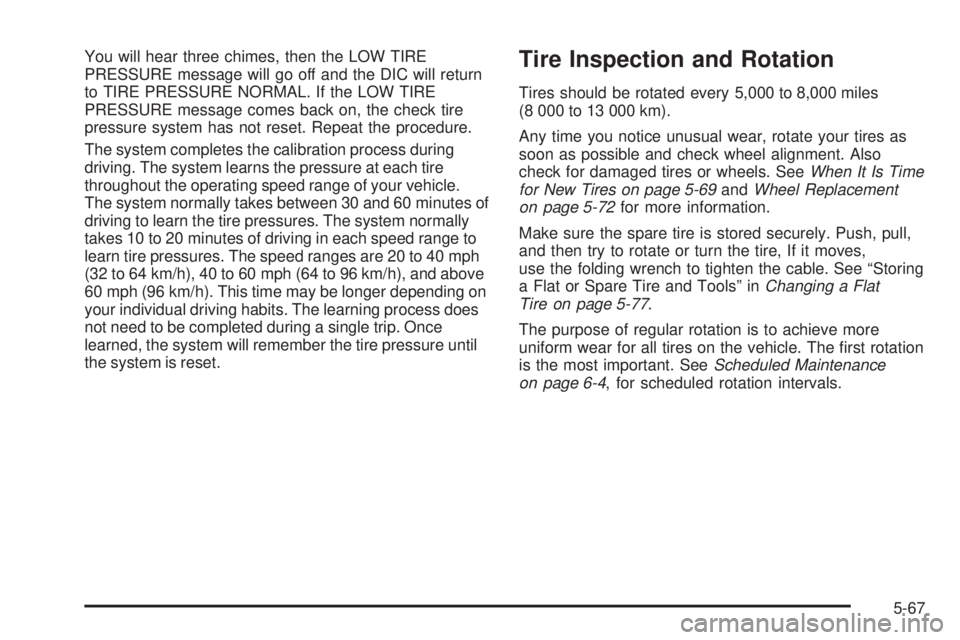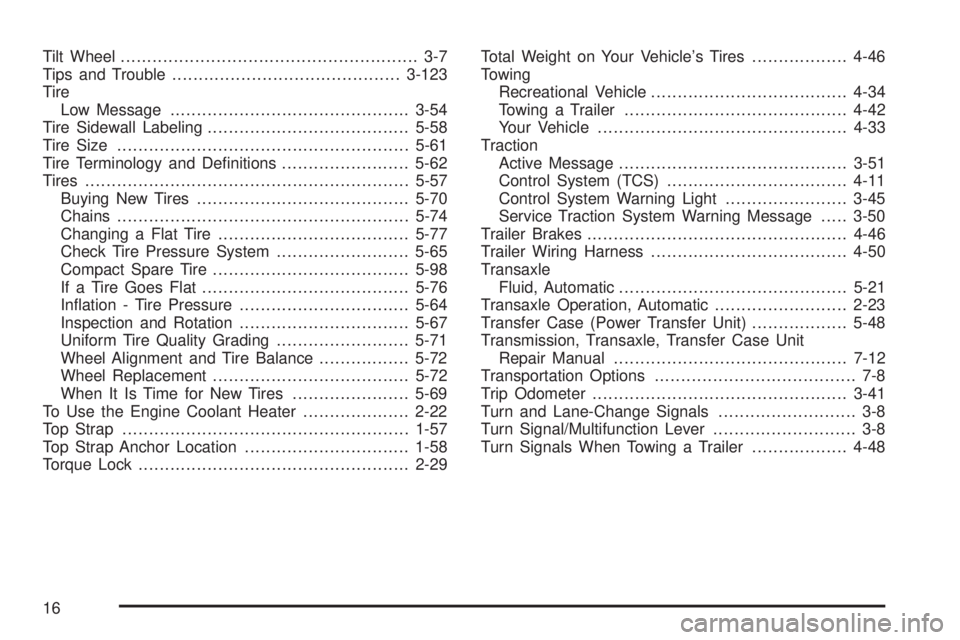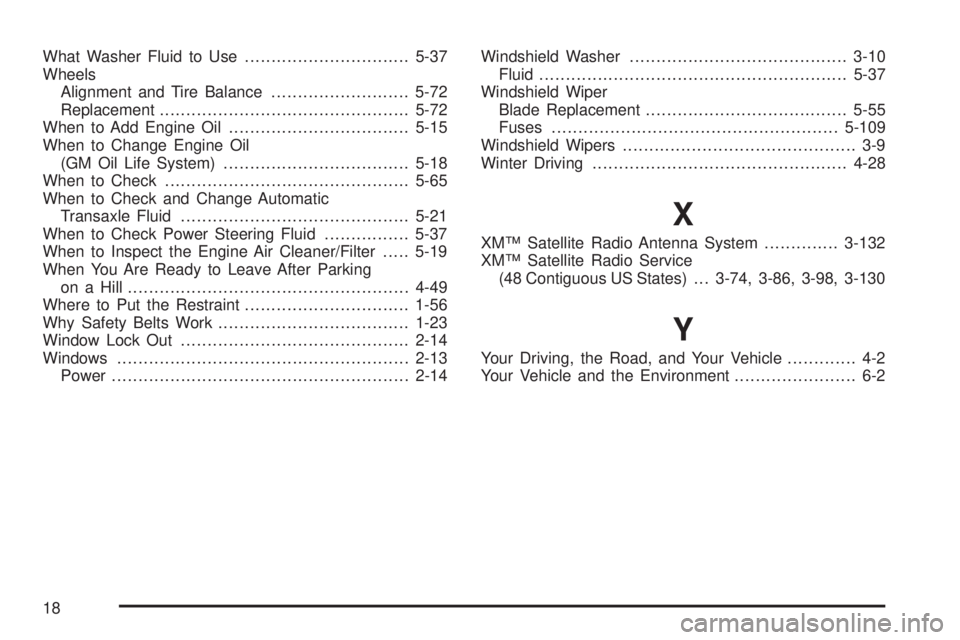wheel alignment BUICK RANDEZVOUS 2004 Owner's Manual
[x] Cancel search | Manufacturer: BUICK, Model Year: 2004, Model line: RANDEZVOUS, Model: BUICK RANDEZVOUS 2004Pages: 486, PDF Size: 3.18 MB
Page 323 of 486

Service............................................................5-3
Doing Your Own Service Work.........................5-3
Adding Equipment to the Outside of Your
Vehicle......................................................5-4
Fuel................................................................5-4
Gasoline Octane............................................5-4
Gasoline Speci�cations....................................5-5
California Fuel...............................................5-5
Additives.......................................................5-6
Fuels in Foreign Countries...............................5-6
Filling Your Tank............................................5-7
Filling a Portable Fuel Container.......................5-9
Checking Things Under the Hood....................5-10
Hood Release..............................................5-11
Engine Compartment Overview.......................5-12
Engine Oil...................................................5-14
Engine Air Cleaner/Filter................................5-19
Automatic Transaxle Fluid..............................5-21
Engine Coolant.............................................5-23
Radiator Pressure Cap..................................5-25
Engine Overheating.......................................5-26
Cooling System............................................5-29
Power Steering Fluid.....................................5-36
Windshield Washer Fluid................................5-37
Brakes........................................................5-38Battery........................................................5-42
Jump Starting...............................................5-43
All-Wheel Drive..............................................5-48
Bulb Replacement..........................................5-50
Halogen Bulbs..............................................5-50
Headlamps..................................................5-50
Front Turn Signal, Sidemarker and Parking
Lamps.....................................................5-52
Taillamps, Turn Signal, and Stoplamps............5-52
Taillamps and Back-Up Lamps.......................5-53
Replacement Bulbs.......................................5-54
Windshield Wiper Blade Replacement..............5-55
Tires..............................................................5-57
In�ation - Tire Pressure.................................5-64
Check Tire Pressure System..........................5-65
Tire Inspection and Rotation...........................5-67
When It Is Time for New Tires.......................5-69
Buying New Tires.........................................5-70
Uniform Tire Quality Grading..........................5-71
Wheel Alignment and Tire Balance..................5-72
Wheel Replacement......................................5-72
Tire Chains..................................................5-74
Accessory In�ator.........................................5-74
Section 5 Service and Appearance Care
5-1
Page 389 of 486

You will hear three chimes, then the LOW TIRE
PRESSURE message will go off and the DIC will return
to TIRE PRESSURE NORMAL. If the LOW TIRE
PRESSURE message comes back on, the check tire
pressure system has not reset. Repeat the procedure.
The system completes the calibration process during
driving. The system learns the pressure at each tire
throughout the operating speed range of your vehicle.
The system normally takes between 30 and 60 minutes of
driving to learn the tire pressures. The system normally
takes 10 to 20 minutes of driving in each speed range to
learn tire pressures. The speed ranges are 20 to 40 mph
(32 to 64 km/h), 40 to 60 mph (64 to 96 km/h), and above
60 mph (96 km/h). This time may be longer depending on
your individual driving habits. The learning process does
not need to be completed during a single trip. Once
learned, the system will remember the tire pressure until
the system is reset.Tire Inspection and Rotation
Tires should be rotated every 5,000 to 8,000 miles
(8 000 to 13 000 km).
Any time you notice unusual wear, rotate your tires as
soon as possible and check wheel alignment. Also
check for damaged tires or wheels. SeeWhen It Is Time
for New Tires on page 5-69andWheel Replacement
on page 5-72for more information.
Make sure the spare tire is stored securely. Push, pull,
and then try to rotate or turn the tire, If it moves,
use the folding wrench to tighten the cable. See “Storing
a Flat or Spare Tire and Tools” inChanging a Flat
Tire on page 5-77.
The purpose of regular rotation is to achieve more
uniform wear for all tires on the vehicle. The �rst rotation
is the most important. SeeScheduled Maintenance
on page 6-4, for scheduled rotation intervals.
5-67
Page 394 of 486

Temperature – A, B, C
The temperature grades are A (the highest), B, and C,
representing the tire’s resistance to the generation
of heat and its ability to dissipate heat when tested
under controlled conditions on a speci�ed indoor
laboratory test wheel. Sustained high temperature can
cause the material of the tire to degenerate and
reduce tire life, and excessive temperature can lead to
sudden tire failure. The grade C corresponds to a
level of performance which all passenger car tires must
meet under the Federal Motor Vehicle Safety Standard
No. 109. Grades B and A represent higher levels of
performance on the laboratory test wheel than the
minimum required by law.
Warning: The temperature grade for this tire is
established for a tire that is properly in�ated and not
overloaded. Excessive speed, underin�ation, or
excessive loading, either separately or in combination,
can cause heat buildup and possible tire failure.
Wheel Alignment and Tire Balance
The wheels on your vehicle were aligned and balanced
carefully at the factory to give you the longest tire life
and best overall performance.Scheduled wheel alignment and wheel balancing are
not needed. However, if you notice unusual tire wear or
your vehicle pulling one way or the other, the alignment
may need to be reset. If you notice your vehicle
vibrating when driving on a smooth road, your wheels
may need to be rebalanced.
Wheel Replacement
Replace any wheel that is bent, cracked or badly rusted
or corroded. If wheel nuts keep coming loose, the
wheel, wheel bolts and wheel nuts should be replaced.
If the wheel leaks air, replace it (except some
aluminum wheels, which can sometimes be repaired).
See your dealer if any of these conditions exist.
Your dealer will know the kind of wheel you need.
Each new wheel should have the same load-carrying
capacity, diameter, width, offset and be mounted
the same way as the one it replaces.
If you need to replace any of your wheels, wheel bolts
or wheel nuts, replace them only with new GM
original equipment parts. This way, you will be sure to
have the right wheel, wheel bolts and wheel nuts
for your vehicle.
5-72
Page 484 of 486

Tilt Wheel........................................................ 3-7
Tips and Trouble...........................................3-123
Tire
Low Message.............................................3-54
Tire Sidewall Labeling......................................5-58
Tire Size.......................................................5-61
Tire Terminology and De�nitions........................5-62
Tires.............................................................5-57
Buying New Tires........................................5-70
Chains.......................................................5-74
Changing a Flat Tire....................................5-77
Check Tire Pressure System.........................5-65
Compact Spare Tire.....................................5-98
If a Tire Goes Flat.......................................5-76
In�ation - Tire Pressure................................5-64
Inspection and Rotation................................5-67
Uniform Tire Quality Grading.........................5-71
Wheel Alignment and Tire Balance.................5-72
Wheel Replacement.....................................5-72
When It Is Time for New Tires......................5-69
To Use the Engine Coolant Heater....................2-22
Top Strap......................................................1-57
Top Strap Anchor Location...............................1-58
Torque Lock...................................................2-29Total Weight on Your Vehicle’s Tires..................4-46
Towing
Recreational Vehicle.....................................4-34
Towing a Trailer..........................................4-42
Your Vehicle...............................................4-33
Traction
Active Message...........................................3-51
Control System (TCS)..................................4-11
Control System Warning Light.......................3-45
Service Traction System Warning Message.....3-50
Trailer Brakes.................................................4-46
Trailer Wiring Harness.....................................4-50
Transaxle
Fluid, Automatic...........................................5-21
Transaxle Operation, Automatic.........................2-23
Transfer Case (Power Transfer Unit)..................5-48
Transmission, Transaxle, Transfer Case Unit
Repair Manual............................................7-12
Transportation Options...................................... 7-8
Trip Odometer................................................3-41
Turn and Lane-Change Signals.......................... 3-8
Turn Signal/Multifunction Lever........................... 3-8
Turn Signals When Towing a Trailer..................4-48
16
Page 486 of 486

What Washer Fluid to Use...............................5-37
Wheels
Alignment and Tire Balance..........................5-72
Replacement...............................................5-72
When to Add Engine Oil..................................5-15
When to Change Engine Oil
(GM Oil Life System)...................................5-18
When to Check..............................................5-65
When to Check and Change Automatic
Transaxle Fluid...........................................5-21
When to Check Power Steering Fluid................5-37
When to Inspect the Engine Air Cleaner/Filter.....5-19
When You Are Ready to Leave After Parking
on a Hill.....................................................4-49
Where to Put the Restraint...............................1-56
Why Safety Belts Work....................................1-23
Window Lock Out...........................................2-14
Windows.......................................................2-13
Power........................................................2-14Windshield Washer.........................................3-10
Fluid..........................................................5-37
Windshield Wiper
Blade Replacement......................................5-55
Fuses......................................................5-109
Windshield Wipers............................................ 3-9
Winter Driving................................................4-28
X
XM™ Satellite Radio Antenna System..............3-132
XM™ Satellite Radio Service
(48 Contiguous US States) . . . 3-74, 3-86, 3-98, 3-130
Y
Your Driving, the Road, and Your Vehicle............. 4-2
Your Vehicle and the Environment....................... 6-2
18